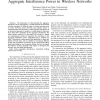Free Online Productivity Tools
i2Speak
i2Symbol
i2OCR
iTex2Img
iWeb2Print
iWeb2Shot
i2Type
iPdf2Split
iPdf2Merge
i2Bopomofo
i2Arabic
i2Style
i2Image
i2PDF
iLatex2Rtf
Sci2ools
VTC
2010
IEEE
2010
IEEE
A Cumulant-Based Characterization of the Aggregate Interference Power in Wireless Networks
— The importance of characterizing the aggregate interference power generated by a wireless network has increased with the emergence of different types of wireless networks such as ad-hoc networks, sensor networks, and cognitive radios. A cumulant-based characterization of this aggregate interference is an attractive approach. A number or recent papers in literature have dealt with cumulants of the aggregate interference but under specific scenarios. In this paper, we introduce a simple yet comprehensive method to determine the cumulants of the aggregate interference power originating from a wireless network. This method is quite general and applicable for finite and infinite network sizes, and it is flexible to encompass different system and propagation parameters such as large-scale fading, small-scale fading or even composite fading. We also investigate the behavior of these cumulants with respect to changes in the network size and fading distributions.
Aggregate Interference | Aggregate Interference Power | Communications | VTC 2010 | Wireless Network |
| Added | 31 Jan 2011 |
| Updated | 31 Jan 2011 |
| Type | Journal |
| Year | 2010 |
| Where | VTC |
| Authors | Muhammad Aljuaid, Halim Yanikomeroglu |
Comments (0)

